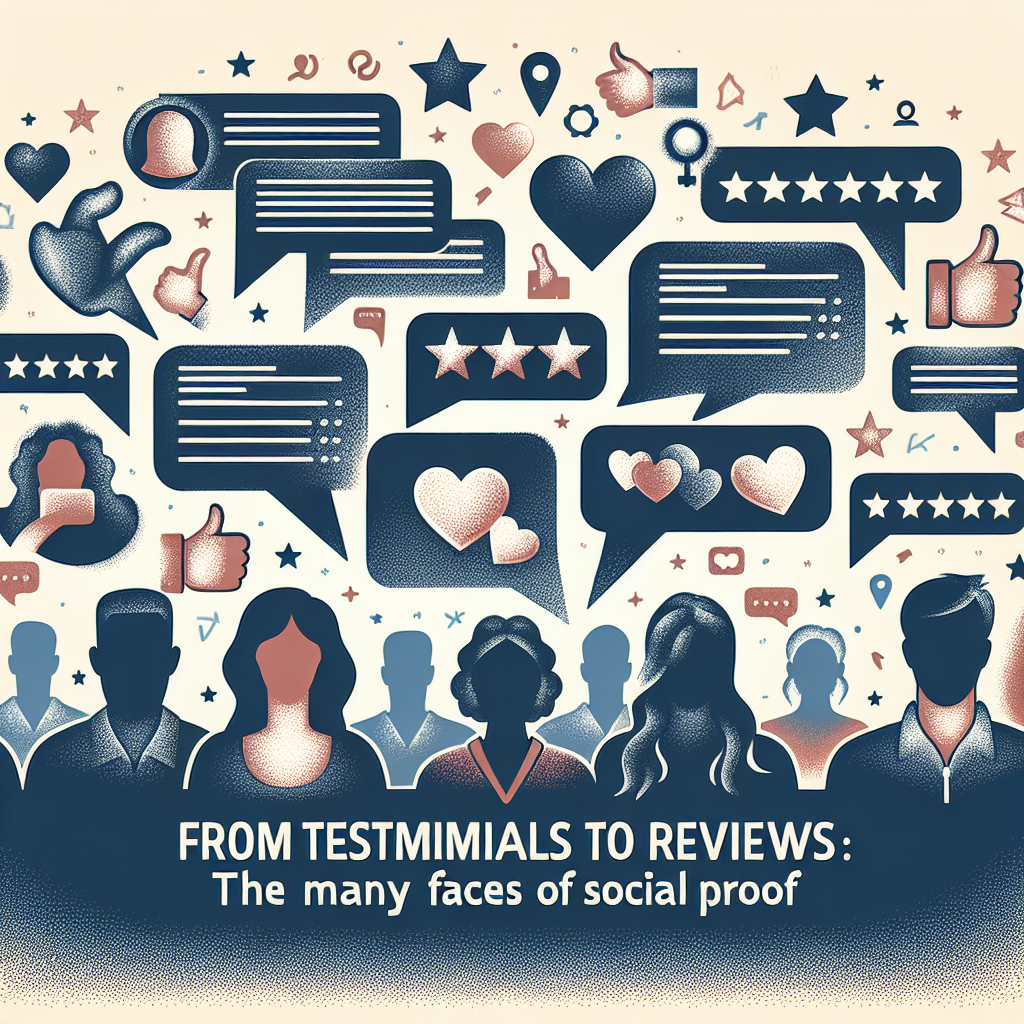
Introduction
In today’s digital landscape, where consumer decisions can pivot on a single review, understanding the varied forms of social proof is more crucial than ever. From the heartfelt words of a customer testimonial to the quick thumbs-up of online reviews, social proof transcends mere marketing; it shapes perceptions and drives purchasing behavior. In this comprehensive exploration, “From Testimonials to Reviews: The Many Faces of Social Proof,” we delve into how these elements influence consumer trust and decision-making and how businesses can leverage them effectively.
The Power of Social Proof
Social proof isn’t just a buzzword; it is a cognitive phenomenon where individuals look to others to determine their own actions, especially in uncertain conditions. Whether you’re deciding on a new restaurant or considering a new product, you instinctively seek endorsements from peers. In fact, studies have shown that up to 79% of consumers trust online reviews as much as personal recommendations, underscoring the potency of social proof in the digital age.
The Spectrum of Social Proof
Social proof exists in multiple formats, each serving a unique purpose in influencing potential buyers. Let’s break them down.
1. Testimonials: Authentic Voices that Resonate
Testimonials are often the first form of social proof that comes to mind. They are personal narratives provided voluntarily by customers, detailing their experiences with a product or service.
Case Study: Apple
Apple has expertly utilized testimonials across its marketing channels. A notable example is the “Shot on iPhone” campaign, which showcases real photos taken by actual iPhone users. This not only serves as a product endorsement but also provides prospective buyers insight into the everyday use and effectiveness of the device.
Analysis: By featuring genuine testimonials from its users, Apple creates an authentic connection that goes beyond traditional marketing, giving potential customers a glimpse into the lives of actual iPhone users.
2. Online Reviews: The Digital Conversation
Unlike testimonials, online reviews can be spontaneous and vary widely in tone and quality. They range from expert critiques on sites like CNET to user reviews on platforms like Amazon and Yelp.
Case Study: Yelp
Yelp is a primary platform where online reviews shine. Businesses often showcase standout positive reviews that can significantly enhance their reputation. For instance, a restaurant that consistently receives high praise for its service can expect a marked increase in foot traffic.
Analysis: The volatile nature of reviews—where a single negative comment can sometimes overshadow numerous positive ones—highlights the importance of actively managing your online reputation.
3. Ratings and Stars: Quick Decisions in a Digital World
Star ratings, often seen alongside online reviews, provide a quick, at-a-glance understanding of a service or product’s quality.
Case Study: TripAdvisor
TripAdvisor uses star ratings to help users make travel decisions. A hotel with a high average rating has a distinct advantage, as consumers often filter their choices based on these ratings.
Analysis: This form of social proof simplifies the decision-making process for consumers, allowing them to sift through options rapidly.
4. Social Media Mentions: Real-Time Validation
In the age of social media, customers don’t just share their opinions; they do so publicly. Whether it’s a photo on Instagram or a tweet about a product, social media mentions act as modern-day testimonials.
Case Study: Glossier
Cosmetics brand Glossier thrives on user-generated content, encouraging its customers to share their experiences on social media. This strategy fosters an engaged community, translating into brand loyalty and trust.
Analysis: By amplifying authentic social interactions, brands can build a robust digital presence and influence potential buyers through the organic engagement of real users.
5. Influencer Endorsements: The New Marketing Powerhouse
In recent years, influencer marketing has gained massive traction. Influencers act as trusted sources, leveraging their follower base to persuade potential buyers.
Case Study: Daniel Wellington
The watch brand Daniel Wellington is renowned for its influencer marketing strategy, partnering with various social media personalities to showcase its products. By utilizing influencers, the brand taps into pre-existing trust and reaches potential customers that traditional advertising might overlook.
Analysis: Influencers provide a form of social proof that combines the authenticity of testimonials with a larger audience reach, making them a valuable asset for brands.
The Intersection of Authenticity and Marketing
The common thread across all these forms of social proof is authenticity. Modern consumers are savvy; they can usually tell when a brand is being disingenuous or overly polished.
Creating Authentic Experiences
- Showcase User-Generated Content: Encourage customers to engage with your brand on social platforms and share their experiences.
- Utilize QR Codes: Link customers directly to your product review pages or testimonials to make it easier for them to explore.
- Engage with Feedback: Respond to reviews, both positive and negative. This can foster a community feeling and helps manage public perception.
The Role of Negative Reviews
While it might seem counterintuitive, negative reviews can also serve as social proof. They highlight transparency and credibility. In fact, consumers may find brands more trustworthy when they acknowledge negative feedback upfront.
Best Practices for Leveraging Social Proof
- Diverse Sources: Include a mix of testimonials, reviews, ratings, and user content.
- Authenticity is Key: Avoid overly polished or scripted testimonials; genuine voices resonate more.
- Stay Engaged: Regularly monitor and respond to feedback on all platforms.
- Visual Storytelling: Use images and videos to make testimonials more relatable.
- Feature Case Studies: Showcase detailed cases that illustrate how your product has solved real problems.
Conclusion
In a world where choices abound, social proof serves as a guiding light for consumers navigating through indecision. From testimonials to reviews, understanding “From Testimonials to Reviews: The Many Faces of Social Proof” equips businesses with the tools to build trust and foster loyalty. By employing authentic voices and strategically managing feedback, companies can create lasting connections with consumers that go beyond mere transactions.
FAQs
1. What is social proof?
Social proof refers to the influence that the actions and opinions of others have on our decision-making. It can take many forms, including testimonials, reviews, and social media mentions.
2. Why are testimonials important?
Testimonials provide authentic voices that help build trust with potential customers. They showcase real experiences, allowing consumers to see the value of a product or service through someone else’s eyes.
3. How can businesses best manage online reviews?
Regularly monitor your reviews across platforms, engage with customers by responding to feedback, and address any negative reviews with professionalism. This builds trust and enhances your brand’s reputation.
4. Are negative reviews bad for a business?
Not necessarily. A mix of positive and negative reviews can enhance transparency and credibility. Addressing negative reviews can also demonstrate a commitment to customer satisfaction.
5. Can social media influence purchasing decisions?
Absolutely. Social media mentions and influencer endorsements can significantly impact consumer choices, often leading to increased brand trust and sales.
In summary, embracing and understanding the various elements of social proof—from testimonials to reviews—can transform how businesses connect with customers, turning potential hesitations into decisive actions.














